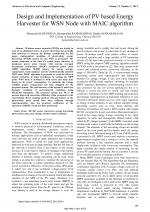| 2/2015 - 14 |
Design and Implementation of PV based Energy Harvester for WSN Node with MAIC algorithmRAJENDRAN, H. |
| Extra paper information in |
| Click to see author's profile in |
| Download PDF |
Author keywords
DC-DC power converters, energy harvesting photovoltaic cells, solar energy, wireless sensor networks
References keywords
power(19), energy(11), tracking(8), solar(7), point(7), maximum(7), systems(6), system(6), sensor(6), harvesting(6)
Blue keywords are present in both the references section and the paper title.
About this article
Date of Publication: 2015-05-31
Volume 15, Issue 2, Year 2015, On page(s): 109 - 116
ISSN: 1582-7445, e-ISSN: 1844-7600
Digital Object Identifier: 10.4316/AECE.2015.02014
Web of Science Accession Number: 000356808900014
SCOPUS ID: 84979846389
Abstract
Wireless sensor networks (WSNs) are hardly in need of an additional source of power other than the normally used batteries, to increase the lifetime considerably. In this paper, mathematical modeling of photovoltaic energy harvesting (PVEH) system for the WSN is presented. The system comprises of the solar PV panel, boost converter as maximum power point tracker with moving averaged incremental conductance (MAIC) maximum power point (MPP) algorithm, Ni-MH battery for energy storage, compensator, buck regulator and the mathematically modeled WSN mote. MAIC algorithm is proposed to avoid the effect of drastic variations in input irradiance, in locking the MPP point. WSN mote is modeled in both active and sleep state based on the power consumption. To maintain the voltage stability, proper compensator has been designed for the proposed system. The performance of the system is tested for dynamic variations of environmental conditions using MATLAB simulation. The proposed system has 50 to 60 percent improved conversion efficiency when compared to the conventional direct coupling method. The parameters of the photovoltaic panel model have been validated through experimentation. Also the practical verification of the operation of MPPT circuit has been performed. |
| References | | | Cited By |
Web of Science® Times Cited: 3 [View]
View record in Web of Science® [View]
View Related Records® [View]
Updated today
SCOPUS® Times Cited: 6
View record in SCOPUS® [Free preview]
View citations in SCOPUS® [Free preview]
[1] New String Reconfiguration Technique for Residential Photovoltaic System Generation Enhancement, CORBA, Z., KATIC, V., POPADIC, B., MILICEVIC, D., Advances in Electrical and Computer Engineering, ISSN 1582-7445, Issue 1, Volume 16, 2016.
Digital Object Identifier: 10.4316/AECE.2016.01003 [CrossRef] [Full text]
[2] Design and implementation of piezoelectric energy harvesting circuit, Savarimuthu, Kirubaveni, Sankararajan, Radha, Murugesan, Sudha, Circuit World, ISSN 0305-6120, Issue 2, Volume 43, 2017.
Digital Object Identifier: 10.1108/CW-12-2016-0065 [CrossRef]
[3] Modeling and Simulation of a Commercial PV/T in MATLAB/Simulink Software Environment, Pop, Teodor, Buzduga, Corneliu, Ifrim, Visarion-Catalin, Pentiuc, Radu-Dumitru, Bejenar, Ciprian, 2022 International Conference and Exposition on Electrical And Power Engineering (EPE), ISBN 978-1-6654-8994-2, 2022.
Digital Object Identifier: 10.1109/EPE56121.2022.9959763 [CrossRef]
[4] Design Testbench for Wireless Sensor Network Based on CC2530 Transceiver, Galkin, Pavlo, 2019 IEEE International Scientific-Practical Conference Problems of Infocommunications, Science and Technology (PIC S&T), ISBN 978-1-7281-4182-4, 2019.
Digital Object Identifier: 10.1109/PICST47496.2019.9061352 [CrossRef]
Disclaimer: All information displayed above was retrieved by using remote connections to respective databases. For the best user experience, we update all data by using background processes, and use caches in order to reduce the load on the servers we retrieve the information from. As we have no control on the availability of the database servers and sometimes the Internet connectivity may be affected, we do not guarantee the information is correct or complete. For the most accurate data, please always consult the database sites directly. Some external links require authentication or an institutional subscription.
Web of Science® is a registered trademark of Clarivate Analytics, Scopus® is a registered trademark of Elsevier B.V., other product names, company names, brand names, trademarks and logos are the property of their respective owners.
Faculty of Electrical Engineering and Computer Science
Stefan cel Mare University of Suceava, Romania
All rights reserved: Advances in Electrical and Computer Engineering is a registered trademark of the Stefan cel Mare University of Suceava. No part of this publication may be reproduced, stored in a retrieval system, photocopied, recorded or archived, without the written permission from the Editor. When authors submit their papers for publication, they agree that the copyright for their article be transferred to the Faculty of Electrical Engineering and Computer Science, Stefan cel Mare University of Suceava, Romania, if and only if the articles are accepted for publication. The copyright covers the exclusive rights to reproduce and distribute the article, including reprints and translations.
Permission for other use: The copyright owner's consent does not extend to copying for general distribution, for promotion, for creating new works, or for resale. Specific written permission must be obtained from the Editor for such copying. Direct linking to files hosted on this website is strictly prohibited.
Disclaimer: Whilst every effort is made by the publishers and editorial board to see that no inaccurate or misleading data, opinions or statements appear in this journal, they wish to make it clear that all information and opinions formulated in the articles, as well as linguistic accuracy, are the sole responsibility of the author.



